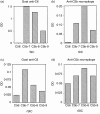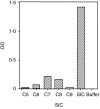Streptococcal inhibitor of complement (SIC) inhibits the membrane attack complex by preventing uptake of C567 onto cell membranes
- PMID: 11454069
- PMCID: PMC1783247
- DOI: 10.1046/j.1365-2567.2001.01249.x
Streptococcal inhibitor of complement (SIC) inhibits the membrane attack complex by preventing uptake of C567 onto cell membranes
Abstract
Streptococcal inhibitor of complement (SIC) was first described in 1996 as a putative inhibitor of the membrane attack complex of complement (MAC). SIC is a 31 000 MW protein secreted in large quantities by the virulent Streptococcus pyogenes strains M1 and M57, and is encoded by a gene which is extremely variable. In order to study further the interactions of SIC with the MAC, we have made a recombinant form of SIC (rSIC) in Escherichia coli and purified native M1 SIC which was used to raise a polyclonal antibody. SIC prevented reactive lysis of guinea pig erythrocytes by the MAC at a stage prior to C5b67 complexes binding to cell membranes, presumably by blocking the transiently expressed membrane insertion site on C7. The ability of SIC and clusterin (another putative fluid phase complement inhibitor) to inhibit complement lysis was compared, and found to be equally efficient. In parallel, by enzyme-linked immunosorbent assay both SIC and rSIC bound strongly to C5b67 and C5b678 complexes and to a lesser extent C5b-9, but only weakly to individual complement components. The implications of these data for virulence of SIC-positive streptococci are discussed, in light of the fact that Gram-positive organisms are already protected against complement lysis by the presence of their peptidoglycan cell walls. We speculate that MAC inhibition may not be the sole function of SIC.
Figures





Similar articles
-
Streptococcal inhibitor of complement inhibits two additional components of the mucosal innate immune system: secretory leukocyte proteinase inhibitor and lysozyme.Infect Immun. 2002 Sep;70(9):4908-16. doi: 10.1128/IAI.70.9.4908-4916.2002. Infect Immun. 2002. PMID: 12183536 Free PMC article.
-
Serum-resistant strains of Borrelia burgdorferi evade complement-mediated killing by expressing a CD59-like complement inhibitory molecule.J Immunol. 2003 Mar 15;170(6):3214-22. doi: 10.4049/jimmunol.170.6.3214. J Immunol. 2003. PMID: 12626580
-
Recombinant C345C and factor I modules of complement components C5 and C7 inhibit C7 incorporation into the complement membrane attack complex.J Immunol. 2005 May 15;174(10):6227-32. doi: 10.4049/jimmunol.174.10.6227. J Immunol. 2005. PMID: 15879120
-
Membrane attack by complement.Mol Immunol. 1984 Jul;21(7):589-603. doi: 10.1016/0161-5890(84)90044-0. Mol Immunol. 1984. PMID: 6379417 Review.
-
Complement C5b-9 and Cancer: Mechanisms of Cell Damage, Cancer Counteractions, and Approaches for Intervention.Front Immunol. 2019 Apr 10;10:752. doi: 10.3389/fimmu.2019.00752. eCollection 2019. Front Immunol. 2019. PMID: 31024572 Free PMC article. Review.
Cited by
-
Protease-dependent mechanisms of complement evasion by bacterial pathogens.Biol Chem. 2012 Sep;393(9):873-88. doi: 10.1515/hsz-2012-0174. Biol Chem. 2012. PMID: 22944688 Free PMC article. Review.
-
Growth characteristics of and virulence factor production by group A Streptococcus during cultivation in human saliva.Infect Immun. 2005 Aug;73(8):4723-31. doi: 10.1128/IAI.73.8.4723-4731.2005. Infect Immun. 2005. PMID: 16040985 Free PMC article.
-
Pathogenic Leptospira Secreted Proteases Target the Membrane Attack Complex: A Potential Role for Thermolysin in Complement Inhibition.Front Microbiol. 2017 May 30;8:958. doi: 10.3389/fmicb.2017.00958. eCollection 2017. Front Microbiol. 2017. PMID: 28611756 Free PMC article.
-
Application of the C3-binding motif of streptococcal pyrogenic exotoxin B to protect mice from invasive group a streptococcal infection.PLoS One. 2015 Jan 28;10(1):e0117268. doi: 10.1371/journal.pone.0117268. eCollection 2015. PLoS One. 2015. PMID: 25629609 Free PMC article.
-
Insight into the molecular basis of pathogen abundance: group A Streptococcus inhibitor of complement inhibits bacterial adherence and internalization into human cells.Proc Natl Acad Sci U S A. 2002 May 28;99(11):7646-51. doi: 10.1073/pnas.112039899. Proc Natl Acad Sci U S A. 2002. PMID: 12032337 Free PMC article.
References
-
- Efstratiou A. Group A streptococci in the 1990s. J Antimicrob Chemother. 2000;45:3–12. 10.1093/jac/45.suppl_1.3. - DOI - PubMed
-
- Song W-C, Sarrias MR, Lambris JD. Complement and innate immunity. Immunopharmacology. 2000;49:187–98. 10.1016/s0162-3109(00)00217-4. - DOI - PubMed
-
- Würzner R. Evasion of pathogens by avoiding recognition or eradication by complement, in part via molecular mimicry. Mol Immunol. 1999;36:249–60. 10.1016/s0161-5890(99)00049-8. - DOI - PubMed
-
- Johnsson E, Berggård K, Kotarsky H, Hellwage J, Zipfel PF, Sjöbring U, Lindahl G. Role of the hypervariable region in streptococcal M proteins: binding of a human complement inhibitor. J Immunol. 1998;161:4894–901. - PubMed
MeSH terms
Substances
LinkOut - more resources
Full Text Sources
Miscellaneous

